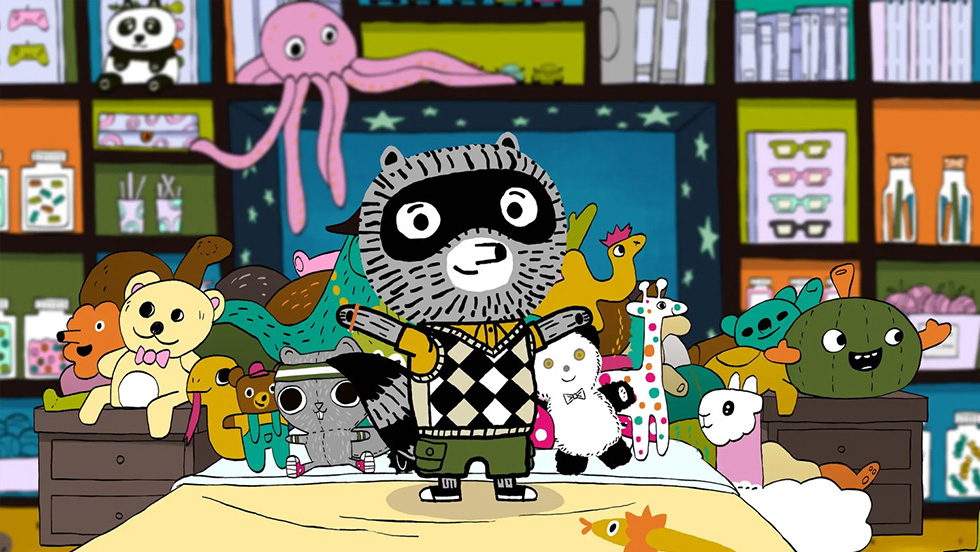
Faculty member advises the first PBS Kids show headlined by a character with autism
At first I thought the creators had taken inspiration from me, because in the reel, the character of Carl was wearing the same kind of clothing I wear, and like me, he was interested in watches and bicycles. But I found out they’d never heard of me when they were putting the character together. They’d just done their research.”
Carl, the hero of the PBS Kids show Carl the Collector, is a young raccoon who loves collecting objects and playing with his animal friends. Carl also has autism, making him the network’s first-ever lead on the spectrum. The show follows Carl as he plans sleepovers, tries to keep his room clean and hashes out disagreements with friends, providing viewers with an up-close look at how people with autism navigate everyday life. “The show did it right from the very beginning,” said Stephen Shore, EdD, clinical associate professor of education at Adelphi, who served as an autism adviser on Carl. “Its creators worked hard to meaningfully involve the autism community and commit to authentic representation.”
Dr. Shore, who is autistic, has traveled the world as a researcher, educator and speaker, appearing before audiences across more than 50 countries. With Carl, he added creative consultant to his résumé. “I had never consulted on a show before,” he said, “but the creators reached out to me out of the blue.” Initially, Dr. Shore was asked to share his thoughts on a promo reel. “At first, I thought the creators had taken inspiration from me, because in the reel, the character of Carl was wearing the same kind of clothing I wear, and like me, he was interested in watches and bicycles. But I found out they’d never heard of me when they were putting the character together. They’d just done their research.”

Stephen Shore, EdD, clinical associate professor at Adelphi
An Integral Part of the Process
Dr. Shore was involved throughout the entire creative process for each episode, from the initial premise to the final rough cut. At each stage of development, he let the creators know if the actions, gestures, speech patterns or reactions of a character with autism did not ring true. Sometimes, he found, even the tiniest adjustment could make all the difference. “For instance, they would have Carl saying, ‘The ice cream social is going to happen in four days.’ I told them an autistic person might actually say, ‘Four days, 11 hours and 56 minutes.’ A lot of people with autism are very exacting.”
Dr. Shore’s expertise—and personal experience—shaped a number of storytelling decisions. When Carl decides to tell a friend why he’s behaving in a certain way, Dr. Shore looked to his own “four-step autism disclosure protocol” for inspiration, which he notes the team put to “good use.” He also advocated for Carl to stim—repetitive behaviors, movements or sounds used to manage emotions or self-soothe—with his fingers in response to specific triggers.
Other stims, such as pacing and jumping on a trampoline, help map out Carl’s thought processes for an audience who may not be familiar with autistic cognition. In one scene in which Carl must make a decision, the show takes viewers inside his brain, dramatizing its inner workings. “Even if people watching can’t immediately relate to Carl, they might gain some insight into how a person with autism thinks through something,” Dr. Shore said. “Then they can generalize that information to better support the people in their life who are on the spectrum.”
Helping to Shape Carl’s Crew
Carl isn’t the only autistic character in Carl the Collector. When the show introduced a second character who has autism, a fox named Lotta, who is hypersensitive to loud sounds and strong smells, Dr. Shore “adopted” her, too. There’s also Paolo, a panda with autism, who is nonspeaking and communicates with a tablet. Together, these three characters challenge the misconception that not all autistic people can talk—and that those who don’t talk don’t still have something to say—or that all individuals with autism tend to behave in one single way.
It’s work that Dr. Shore is proud to have a hand in, especially on television screens nationwide. “I often say that when you’ve met one autistic person, you’ve met one autistic person,” he said. “That doesn’t mean we’re fundamentally different from neurotypical people, either. We’re all more similar than we are different.”
Read more in the 2025 issue of Academic & Creative Research Magazine, where we highlight the innovation and imagination shaping Adelphi’s academic community.
About Our Faculty
Stephen Shore, EdD, is a clinical associate professor in the School of Education. Dr. Shore is on the board of directors of Autism Speaks, is a frequent speaker on the topic of autism, and the author of College for Students With Disabilities and Understanding Autism for Dummies. His work focuses on helping persons with autism and other conditions lead fulfilling and productive lives to their greatest potential.